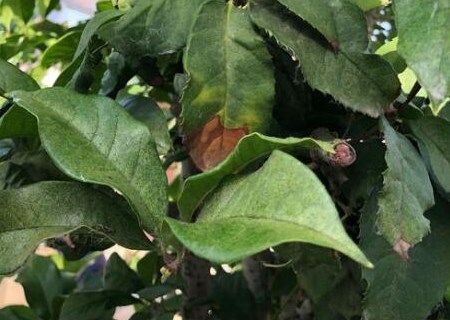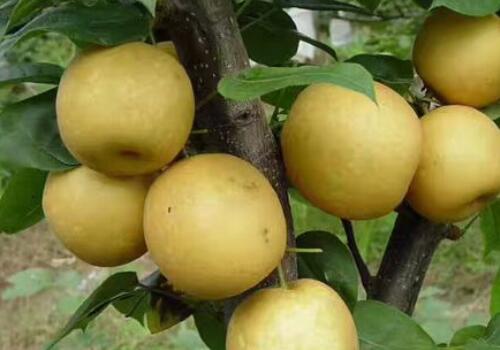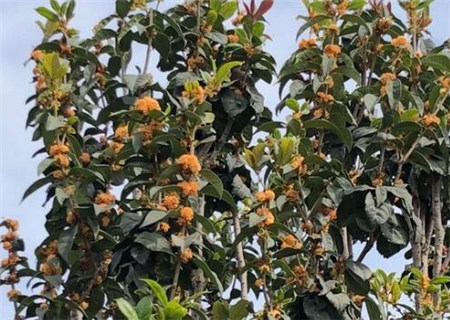What if the leaves of the traditional sweet-scented osmanthus trees are dry and yellow? Why can't you grow it at home? How to grow well?
Sweet-scented osmanthus is a common name for many trees of the genus Oleaceae in China. It is an evergreen shrub or small tree of Oleaceae. It has a wide variety of gardening, so do you know what to do when the leaves of sweet-scented osmanthus are withered and yellowed during planting? Why can't you grow it at home? How to grow well?

What if the leaves of Osmanthus fragrans are withered and yellowed
1. More water or less water is not allowed.
The soil where cinnamon trees are planted must have good ventilation, and it is very afraid of a lot of water. For the conservation of sweet-scented osmanthus, it is best that the soil is not dry and not watered, and every time it is watered, it must be thoroughly watered. If you water too much, the root of the cinnamon tree will become black and rotten, and the tip of the leaf will wither, and then the whole leaf will gradually wither, turn yellow and wither.
2. The irradiation of light is very important.
Cinnamon tree is a kind of plant that likes sunny and cool areas. it needs sunlight for 6 to 8 hours every day, and the regional temperature for planting it should not be lower than 14 ℃. In late summer and early autumn, the temperature should be kept at 24 to 28 ℃, while the winter temperature should be above 0 ℃.
3. Adapt to the high temperature
① cinnamon trees should be placed in a room with plenty of light in winter, so that they can not only safely survive the winter, but also safely through the dormancy period. The temperature had better be controlled at 5 to 8 ℃, otherwise the budding period will be advanced and some bad effects will appear.
The most suitable temperature for ② growth should be 25 to 30 ℃, and the flowering period is in the bright autumn, and it is best to control the temperature at 15 to 20 ℃, below which the flowering time will be delayed, and above this temperature, the flowering period will be advanced and the flowering period will be shortened.
4. Ventilation won't get sick.
Cinnamon trees through the smooth flow of air, not only increase the humidity around the potted plants, but also around the leaves with bacteria, the use of air circulation, so that it is not vulnerable to bacterial infection.
5. Get nutrition and be physically strong
Cinnamon tree is also a delicate plant, a moment of negligence may make it sick, then in ordinary times we can provide it with some potassium or rotten reproductive fertilizer, so that it can gradually improve its immunity and have a resistance to foreign germs. let it thrive.
As long as you pay attention to the above points, the sweet-scented osmanthus at home will be more and more prosperous!
Why can't sweet-scented osmanthus trees be planted at home
The inability to grow sweet-scented osmanthus is basically derived from the old saying.
There are clouds in the Yin-Yang House Classic; sweet-scented osmanthus flowers in the courtyard and ghosts outside the house. Both ancient and modern sweet-scented osmanthus trees are a sign of bad luck in the family. There are also clouds; in front of the sweet-scented osmanthus tree, dignitaries stand inside. Therefore, it is said that the number of sweet-scented osmanthus is not good for planting in the door, but if it is planted in front of the door, it is an auspicious picture, and if it is planted in the courtyard, it will lead to evil spirits to be admitted to the hospital, which is unlucky, and there will often be disputes between words and words.
Although it is a superstition, I still don't believe it if I believe it.
Why can't you plant it at home:
Sweet-scented osmanthus can be planted at home, but it depends on whether you respect superstition.
Osmanthus fragrans, also known as rhinoceros, rock laurel, laurel, is an evergreen shrub or small tree of Oleaceae. There are cinnamon, silver cinnamon, cinnamon, laurel and so on. Osmanthus fragrans is one of the top ten traditional flowers in China. It is an excellent ornamental and practical garden tree species integrating greening, beautification and fragrance.
Sweet-scented osmanthus like warmth, strong resistance, not only high temperature, but also more cold-resistant. Osmanthus fragrans prefer sunshine and can tolerate shade. Under full light, its branches and leaves grow luxuriantly, bloom densely, grow sparsely in shade and flowers are sparse. If you plant potted plants indoors in the north, you should pay special attention to sufficient light to facilitate growth and flower bud formation.
The sweet-scented osmanthus planted at home had better be planted in the balcony or courtyard in a sunny position, which is beneficial to its normal growth and flowering.
Third, how can sweet-scented osmanthus trees grow well
1, timely watering: sweet-scented osmanthus pot soil should grasp the principle of whether it is dry or irrigated, but spray fresh water to the leaves once a day. After the Qingming Festival, the sweet-scented osmanthus should be watered once in the open air, which should be watered in the morning and evening in summer and around noon in winter, so that the water temperature is close to the soil temperature, so as not to cause sudden cold and heat, and pay attention not to stagnant water.
2. Rational fertilization: sweet-scented osmanthus is mainly ornamental, and sufficient fertilizer should be provided. Nitrogen fertilizer can be applied twice during shoot sprouting, and phosphorus fertilizer is mainly applied before flower bud differentiation and flowering. The basin soil should be a little drier before fertilization, and it is appropriate to loosen the soil first so that the fertilizer can be absorbed, and water should be watered the next day.
3. Pour the basin and change the soil: the sweet-scented osmanthus should change the soil once every 2 ~ 3 years, cut off part of the old and withered roots, cover the bottom of the basin with a layer of river sand or vermiculite to facilitate ventilation and drainage, and place rotten cake fertilizer as the base fertilizer, the fill must be compacted. The ratio of soil to soil is not very strict, and it can usually be made of garden soil, barnyard manure and river sand.
4. Pruning and shaping: Osmanthus fragrans generally adopt the method of combination of climbing and pruning, which should be carried out after autumn. Plants with poor tree shape can cut off the whole top branch at 2 / 3 or 3 / 4, and plants with too dense branches should be thinned. After flowering, they should also cut off overgrown branches, withered branches, disease and insect branches, dense and thin branches.
5. Overwintering management: sweet-scented osmanthus overwintering room temperature should be kept at 0: 5 ℃ and relative humidity at 50: 80%. Winter cold indoor light should be good, especially before the early spring buds began to sprout, but also required sufficient sunshine, the following year Grain Rain arranged potted sweet-scented osmanthus to come out of the room. After leaving the room, first concentrate on the outdoor leeward to the sun, so that it gradually adapt to the external environment.
6. disease control: the common diseases of sweet-scented osmanthus are leaf spot, coal pollution, algae spot, root rot, iron deficiency and so on. Leaf spot, coal pollution and algal spot can be sprayed with 0.5 Bordeaux solution or 5% carbendazim 500-1000 times. Root rot should pay attention to keep the soil loose and permeable, do not accumulate water.
7. pest control: the common pests of sweet-scented osmanthus are leaf wasp, whitefly, mite, white scale, yellow moth and so on. Leaf wasps, whitefly and mites can be sprayed with 40% dimethoate 1500-3000 times liquid, and Changbai scale can be sprayed with 40% omethoate 1000 times solution or 40% fenitrothion 500 times solution in the first and second generation nymphs except manual brushing.
Time: 2019-03-17 Click:
- Prev

How much is the price of "June Snow" Cuiguan pear seedlings? How many years has it been planted? What are the places of origin? The prospect of development is as follows
Cuiguan pear is a honey pear, also known as June snow, with thin skin, crisp and juicy flesh, thick and tender taste and sweet juice. It was listed 2 to 3 months earlier than Yali pear and Dangshan pear in the north. How much is the Cuiguan pear seedling? How many years has it been planted? What are the places of origin? What are the prospects for development?
- Next

What are the cultivation methods of Osmanthus fragrans in Oleaceae? How to control diseases and insect pests? How long do you usually live?
Sweet-scented osmanthus tea made from sweet-scented osmanthus is a Chinese specialty tea. It has a soft aroma and delicious taste, and is loved by the public. Osmanthus fragrans is widely used in garden construction. So do you know the cultivation methods of sweet-scented osmanthus trees? How to control diseases and insect pests? How long do you usually live? What are the cultivation methods of Osmanthus fragrans
Related
- Fuxing push coffee new agricultural production and marketing class: lack of small-scale processing plants
- Jujube rice field leisure farm deep ploughing Yilan for five years to create a space for organic food and play
- Nongyu Farm-A trial of organic papaya for brave women with advanced technology
- Four points for attention in the prevention and control of diseases and insect pests of edible fungi
- How to add nutrient solution to Edible Fungi
- Is there any good way to control edible fungus mites?
- Open Inoculation Technology of Edible Fungi
- Is there any clever way to use fertilizer for edible fungus in winter?
- What agents are used to kill the pathogens of edible fungi in the mushroom shed?
- Rapid drying of Edible Fungi

